#great kanto earthquake
Explore tagged Tumblr posts
Text
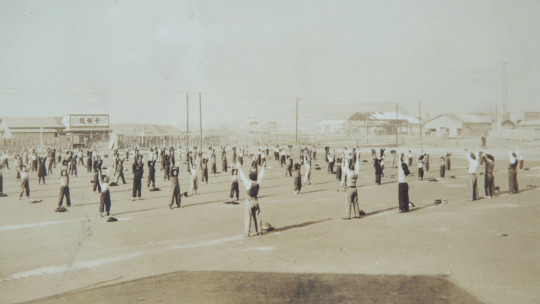
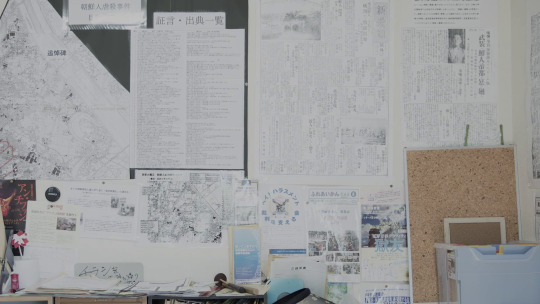
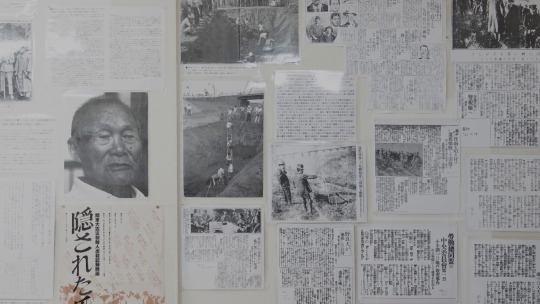

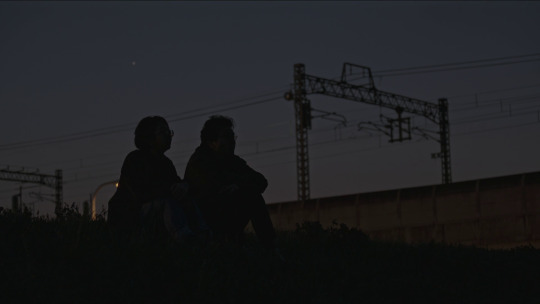

Koki Tanaka
- Vulnerable Histories (A Road Movie)
2019
60 notes
·
View notes
Text
instagram
#Pachinko Ep7, on #AppleTvPlus, a backstory of history 100yrs ago — Sept. 1, 1923 Great #KantōEarthquake
(Yokohama, Chiba & Saitama) & #KantōMassacre, mass murder of #Zainichi, Koreans residing in Japan committed in its aftermath. Japan colonized Korea for 35 yrs from 1910-1945.
2 notes
·
View notes
Text
Realizing Oneness Together: Why Sharing Reiki Healing Matters
Realizing our connection and oneness with each other and the universe, the basic underlying principle of the system of Reiki, is often enhanced in communion with others.
In December 2011, I had been receiving Reiki sessions for about four months and, despite my skepticism, experienced regular benefits and had a series of increasingly significant inner realizations. One night I was sitting in my car after grocery shopping and saw a man on the other side of the parking lot weeping as he was talking to a woman. I felt such empathy with him and had the thought and…

View On WordPress
#connection#Great Kanto Earthquake#healing#Japan#Mikao Usui#Mount Karama#Reiki#spiritual#stress#Tokyo#touch#Usui Reiki Ryoho#Usui Reiki Ryōhō Gakkai
0 notes
Text
fun fact! the contemporary Japanese constitution as amended does not and can't exist in bsd. this isn't conjecture— there are institutions that still exist in bsd that were dissolved by Japan's current constitution, and the events leading to Japan's current constitution have not happened in bsd.
Japan's constitution was rewritten by US General Douglas MacArthur in 1946, in the aftermath of WW2. But WW2 hasn't happened in bsd. (This is also not really conjecture; it's evidenced by there being a Great War and Fukuchi's aims to prevent a second would-be-greater war— irl, the Great War was only called that prior to WW2 because it was, until WW2, the most destructive, widespread war in the modern world. We then had an even greater war and so began numbering them.)
but, it's not even only that WW2 hasn't happened. you might have noticed bsd's Great War parallels but doesn't mirror irl!WW1— in bsd; the international alliances were different (ex: France was allied with Japan and Germany); Japan disengaged from the Great War before its conclusion (after Fukuzawa killed Japan's war hawks); the subsequent peace treaty was between France, Germany, and England (in lieu of the Treaty of Versailles); different nation states arose in the aftermath (the Republic of Nares only exists in bsd, it never existed irl— but WW1 did collapse empires and beget several new nations); the Great War beget the United Nations instead of the League of Nations; etc.
it's not clear precisely where bsd's alternate history breaks from ours— or if there was ever even a break or if it's an entirely parallel timeline—but it is canon that the Port Treaties that forcefully opened irl Japan exist in bsd but were never abolished like they were irl in 1899. it's canon that Suribachi City formed after itty bitty baby Chuuya black hole kaiju'ed a foreign settlement in Yokohama since there wasn't any appetite to rebuild it— which means that as recently as approximately a decade prior to canon, there were still foreign settlements in Japan. this is further confirmed by the Colonel in 55 Minutes.
all of this to illustrate: any claim regarding bsd!Japan's laws based on irl!contemporary Japan is incorrect unless specifically affirmed in canon. Based on the information we've been given thus far, the two Japans are operating on completely different legal frameworks.
in other words, there's no basis for deciding same sex marriage is illegal in bsd!Japan until Kafka Asagiri writes it into canon.*
*For example, I'm fairly certain Yokohama's municipal tax laws and regulations are similar enough to irl!Yokohama because Kunikida mentions a specific tax zone in Osamu Dazai's Entrance Exam that seemingly aligns with a tax zone specific to some contemporary Japanese municipalities, including Yokohama.
*Random fanfic of any gay BSD ships getting proposed to/are married/seems like they are married
“it’s cute and all but you’re forgetting that gay marriage is illegal in Japan”
Stfu, they are literally part of the mafia and have killed poeple, you really think they’d care about that💀
#bsd#bungou stray dogs#i wont get into how wildly different anglo american law is from eastern asian legal systems#but the prior constitution and the constitution written by americans. were not operating under even the same philosophical frameworks.#much less the same laws#so even if bsd had the meiji era constitution#you CANNOT use irl contemporary japan as a reference#the great kanto earthquake still happened btw#based on the agency office's architecture#just a fun little tidbit for you#there's a LOT of information about the timeline in canon if you play spot the differences#and asagiri is careful to trace the consequences of the deviations insofar as ive been able to catch them#it's not perfect and certainly oversimplified in the way that fictional histories and geopolitics usually are#but there's a lot of worldbuilding to catch by brushing up on irl history#also im a transpacific american lawyer if that helps add any validity to my understanding of legal developments in modern japan#like completely separate from my bsd specific research#i work & network with japanese lawyers + attend CLEs and seminars on east asian law + took int'l and china law courses in law school#my firm attends our industry relevant japanese law conference#etc etc etc#this isnt legal advice and im not licensed in japan but i feel pretty good about my ability to clock the difference#between the special division's parent department and the one currently authorized under japan's constitution#as another example of the differences#the special division's parent cabinet was dissolved in 1947 btw. like if you look at the japanese raws#the name is not the name of the current closest-sounding ministry. its the imperial era ministry's name.
1K notes
·
View notes
Text

"Kaneko Fumiko (1903–1926) was a Japanese anarchist living at the early part of the 20th century. Born out of wedlock into grinding poverty, she lived her life as an outsider within Japanese society including a stint with unloving and cruel relatives in then-occupied Korea, her experiences inspiring both her rebellion against authority and feelings of solidarity with others on the receiving end of society’s boot. Together with her friend, partner and, before her death, husband Pak Yol, she started underground anarchist societies, published articles against the Japanese state and society, and, perhaps, planned to kill the Emperor Taisho and then-Crown Prince Hirohito at Hirohito’s wedding.
She and Pak were some of of many who’d be swept up in the mass arrests and killings of enemies of the state both real and perceived after the Great Kanto Earthquake of 1923. Placed into “protective custody,” she and Pak were tried and sentenced to death for high treason on charges related to a plot to kill the Emperor and Crown Prince. While these sentences was later commuted to life in prison by the Emperor, an honor she promptly rejected by tearing the decree up in front of her jailers, she was found hanging in her cell in 1926 and is supposed to have committed suicide." - Because I Wanted To
#anarchism#anticapitalism#queer anarchism#anticiv#leftist memes#anarcho nihilism#egoism#nihilism#anarchist memes#anticapitalist#post left
130 notes
·
View notes
Note
Wait a sec, so if Hiro was a time traveler who fast forward through 100 years did he leave anyone behind in the past like say.. a wife or maybe a child?
Did Hiro have any family ?
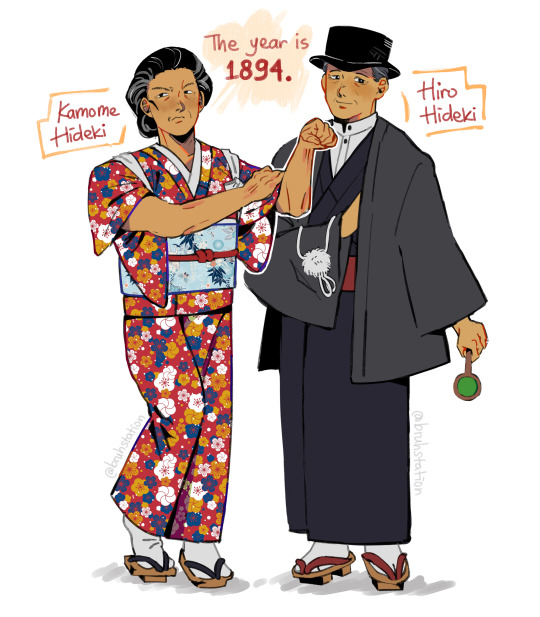
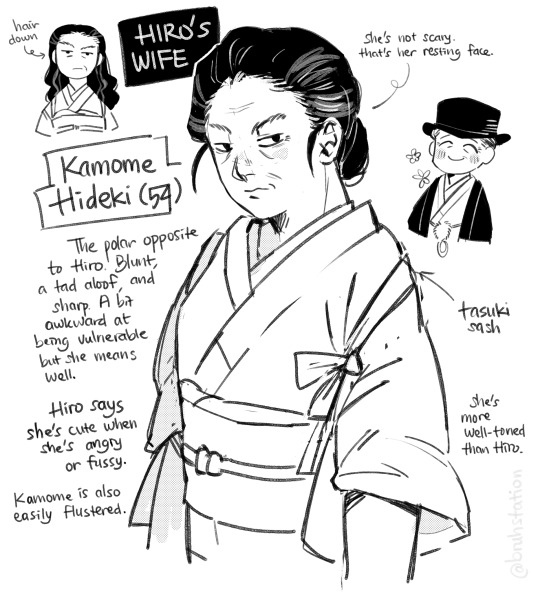

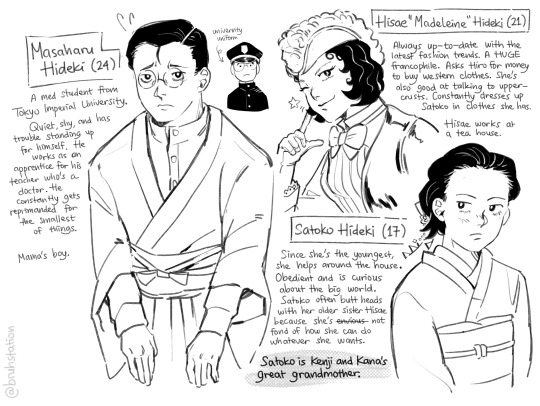
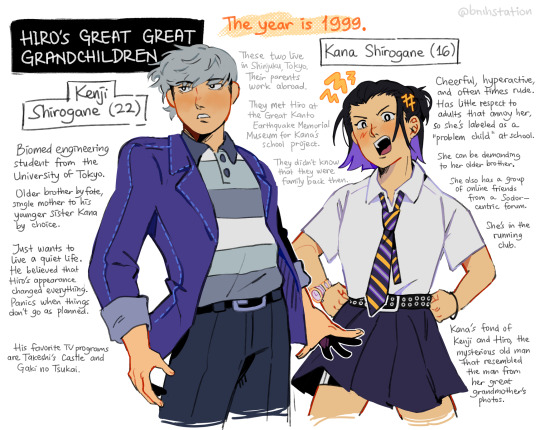
hiro does, sadly. his family never knew what happened to him despite the outrage his disappearance sparked in japan, and hiro in casa tidmouth didn’t know how the entirety of his nuclear family got destroyed by one of japan’s greatest natural catasthropes.
hiro’s wife and children (except satoko) were eventually wiped out the Great Kanto Earthquake in 1923, but he does have descendants of his own that he managed to meet after the events of casa tidmouth’s Hero of the Rails arc.
(more info about them under the cut)
THE YEAR IS 1894.
Hiro Hideki
秀紀 弘 Hideki Hiro
Age: 57 (before transportation, canon Casa Tidmouth is 62)
The patriarch of the Hideki family. Wise, calm, level headed, but has a tendency to overwork himself and put others before himself. He has a mindset of finishing his work first before rewarding himself with the most basic necessities such as eating or going to the bathroom which exasperated Kamome.
Hiro originated from 1894, the Meiji era. Before he was transported to 1994, he’s a civil engineer and railway inspector that was heavily involved during the modernization and westernization of Japan and oversaw the construction of the Tokyo to Yokohama railway in 1872 and its subsequent expansion to Kozu in the following years.
In an attempt to further the connections with the United Kingdom and as part of a collaboration to improvise their engines and railways, the Emperor formed a research group and sent them to England and its surrounding islands – one of them being the Island of Sodor, infamous for its rumored supernatural influence and cases of outsiders going missing (not a great idea, Emperor). Hiro was sent there alongside his colleagues and seniors and the next thing he knew… his environment was alien, his clothes were tattered, he cannot remember anything, and he’s all alone in a steep siding.
Kamome Hideki
秀紀 鴎 Hideki Kamome
Age: 54 (83 at death)
Hiro’s wife. Their marriage was arranged by their parents but Hiro fell in love with her at first sight. While Hiro speaks gently and avoids unnecessary conflict, Kamome is blunt and goes straight to the point when talking. She was constantly seen wearing a tasuki sash and was well-toned for her age. The neighbors and family’s acquaintances see her as a scary woman with a sharp tongue and even sharper eyes, but… that’s just how her face is. Kamome doesn’t take compliments well and instead of smiling, she usually purses her lips or scrunch her eyebrows to express her happiness (Hiro thinks it’s cute).
During the early years of Hiro’s disappearance, Kamome put on a strong facade for their children. She didn’t have much financial worries because their children already had jobs. Hirokazu’s and Akira’s families visit from time to time, and Kamome quickly came into terms with Hiro’s disappearance, but the loneliness and frustration inside her heart still well.
I took her given name from the limited express train service that JR Kyushu operated, Kamome. Her name also means “seagull”.
Hirokazu Hideki
秀紀 弘和 Hideki Hirokazu
Age: 34 (63 at death)
Hiro’s eldest son. He was named after his father. Hirokazu was a serious, rigid man — always bent on following every rule there in his line of work and wouldn't hesitate to reprimand people for messing up. He liked expressing his thoughts (usually related to Japanese politics) without sugarcoating anything and got a knack for debating with his peers, so he’s often exhausted with his father who’s always calm and open to anything Hirokazu says without refuting much of his opinions. Despite being polar opposites, Hirokazu greatly respected and adored Hiro — hence why he followed in his footsteps to become a civil engineer.
Ever since Hiro disappeared, everytime Kamome looked at Hirokazu she felt like he resembled Hiro more and more. Hirokazu’s responsibility in taking care of his family (especially his elderly mother) grew stronger and his need to live up to his father’s legacy eats away at him.
Akira Hideki
秀紀 明 Hideki Akira
Age: 31 (60 at death)
A shy, stoic woman whose social battery drains quickly. She’s soft spoken and doesn’t talk much because of her social anxiety, so he enjoyed conversations with her gentle father more. Akira is also kinda awkward at socializing — behind her neutral face, she’s constantly nervous when faced with a crowd or an unexpected acquaintance of either his father or mother who wanted to chat with her, something she’s extremely self conscious about (Hiro told her she’s fine the way she is). When she succeeded in a conversation, however, she got all fired up and overly proud of herself Akira married a wealthy textile businessman who’s been seeing her for a while and is incredibly smitten with her.
After Hiro went missing, Akira’s husband, mother, and siblings often find her wandering around the train station, sitting solemnly or even asking railwaymen and random passersby if they’ve seen her father. She wasn’t doing mentally well, but luckily her family was there for her.
Masaharu Hideki
秀紀 雅治 Hideki Masaharu
Age: 24 (53 at death)
A student from the Tokyo Imperial University. He studies medicine and was an apprentice of his professor at a hospital in Tokyo. He’s timid, always stressed out, and have trouble standing up for himself, especially against his professor who always reprimand him for even the smallest things such as being late to a conference or being too slow to hand him an operating tool. Masaharu was also a mama’s boy. Kamome fusses over him and always tells him to eat more. Hiro too, but he’s not the most stern.
His professor used his connections to help Masaharu look for his father. Rescue teams, fellow colleagues from Europe, even autopsy labs and funeral homes — he looked everywhere, yet he and Masaharu are stumped. Masaharu felt so useless and even considered dropping out, but Kamome and Hirokazu dragged him back to reality, which made Masaharu end up crying.
Hisae Hideki
秀紀 久愛 Hideki Hisae
Age: 21 (50 at death)
Spunky, stubborn, and always up-to-date. She is IN LOVE with western fashion and a HUGE francophile. She’s a tad spoiled and always asks Hiro for some money whenever new clothes hit the market. Hisae likes dressing up her younger sister Satoko in various clothes she made or bought. She also worked at Irohanayama’s tea house because government officials and their wives always visit in their western attire. She’s also good at talking with people and pleasing upper-crusts. She dreamed of visiting France someday, though this is mostly because of the rose-tinted glasses she has for Europe.
After Hiro went missing, Hisae spent most of her days moping, not wanting to eat or leave her room until Hirokazu and Satoko convinced her to. One day, she suddenly stopped holing herself up in her room, quit her tea house job, and planned on opening her own clothes shop.
Satoko Hideki
秀紀 聡子 Hideki Satoko
Age: 17 (46 during Great Kanto Earthquake)
Being the youngest and most obedient, Kamome frequently asked her to go out to town to run errands. Generally a quiet person, though she always butt heads with her more hotheaded sister Hisae. Most of her clothes during her late teenage years are hand-me-downs from her. She didn’t really have any notable abilities or talents, but she likes collecting hairpins and combs.
In 1923, Satoko survived the Great Kanto Earthquake because she lived at her husband’s hometown far from Tokyo, making her the only living member of Hiro’s nuclear family (some grandchildren from the Hideki family survived but that’s another story. It’ll make this tree longer)
She is Kenji and Kana’s great grandmother.
———
THE YEAR IS 1999.
Kenji and Kana met Hiro during their visit to the Great Kanto Earthquake Memorial Museum. When Kana was taking pictures of the memorial hall for her school assignments, Kana spotted Hiro staring at the list of names. Kenji went to the bathroom for a second, and Kana saw Hiro sitting alone on the bench. Kana sat beside him and sparked a conversation, leading to them eventually becoming friends. Kenji joined them shortly after, and they parted ways soon after it got dark and Kana urged Kenji to take her home so she can print her photos. Hiro bid them farewell, looking wistful but also satisfied with himself.
Neither of them knew that they’re Hiro’s great great grandchildren… until much, much, later.
Kenji Shirogane
���鐘 健二 Shirogane Kenji
Age: 22
Lives in Shinjuku, Tokyo, with his younger sister, Kana. Ever since their parents went abroad for work-related purposes, Kenji has been acting as a guardian for his sister. He studies biomed at Tokyo University in Bunkyou. He goes there via the Yamanote line.
Kenji’s great at cooking and Kana only likes his curry rice because he doesn’t put any “weird” vegetables in it. He likes Japanese variety shows like Takeshi’s Castle and Gaki no Tsukai.
Kana Shirogane
白鐘 華菜 Shirogane Kana
Age: 16
Lives in Shinjuku, Tokyo, with her older brother, Kenji. Second year in high school. She’s in the sports club at her school and is a star for the girls’ running team. A cheerful and hyperactive girl, Kana is rather mischievous and can put on crocodile tears whenever Kenji doesn’t allow her to do something. She frequently gets into trouble at school because of her purple inner dye and grommet belt.
Kana is also quite foul-mouthed and has little respect towards most adults that boss her around, labeling her as a problem child at school. Kenji’s fond of her, but he also describes her as “disrespectful towards older folks”. She would also pull on his nose whenever she’s hungry in the middle of the night and saw Kenji sleeping by the couch to wake him up. However, she truly cares about her family and loves her older brother. Kana’s just a kid being a kid.
#asks#isjssjsjshuuuuuuuuuuuuyyyyyyyyyy#ttte hiro#ttte kenji#ttte kana#kamome (oc)#hirokazu (oc)#akira (oc)#masaharu (oc)#hisae (oc)#satoko (oc)#casa tidmouth#casa tidmouth act 2#senjart#(insert spencer whispering into hiro’s ear about how nobody is waiting for him in japan)
238 notes
·
View notes
Text
神奈川県
Japanese Prefectures: Kantō - Kanagawa
都道府県 (とどうふけん) - Prefectures of Japan
Learning the kanji and a little bit about each of Japan’s 47 prefectures!
Kanji・漢字
神 かみ、かん~、こう~、シン、ジン、かな gods, mind, soul
奈 いかん、からなし、ナ、ナイ、ダイ Nara
川 かわ、セン stream; river
県 ケン prefecture
関東 かんとう Kanto, region consisting of Tokyo and surrounding prefectures
Prefectural Capital (県庁所在地) : Yokohama (横浜市)

Kanagawa Prefecture is located just south of Tokyo. It is home to many day trip destinations from Tokyo, including the cities of Kamakura and Hakone. The prefectural capital of Yokohama on the Pacific coast is Japan's second largest city and its major port, including many multicultural influences such as a China Town and the Minato Mirai building. The port areas are also major centres of bonito and tuna fishing. Inland, Kanagawa has a flourishing agricultural area producing flowers and dairy products for the Tokyo market.
Recommended Tourist Spot・おすすめ観光スポット The Great Buddha of Kamakura - 鎌倉大仏

The Great Buddha of Kamakura (source)
At the Buddhist temple Kotoku-in (高徳院) in Kamakura stands the 11-metre tall 13th-century bronze statue of Amida Buddha. Initially housed in a wooden hall, it was restored in the Edo period (1603-1868) after being damaged over the years by typhoons and earthquakes and now towers over the grounds of the temple. The Great Buddha of Kamakura is the second largest seated Buddha in Japan.
After you visit the Great Buddha, you can also find other Zen Buddhist temples, which are among the oldest and most beautiful in the country, and most in walking distance from each other. Enoshima and the Kamakura beaches are also nearby.
Regional Cuisine - 郷土料理 Kuro-tamago (Black eggs) - 黒卵 (くろたまご)

Kuro-tamago or Black eggs (source)
It may seem strange, but this popular souvenir from the Owakudani (大涌谷 or Great Boiling Valley) in the resort town of Hakone in Kanagawa Prefecture gets its distinctive black color from being boiled in natural hot spring water for 60 minutes at a temperature of 80°C, then steamed at 100°C for 15 minutes in steel baskets over natural hot spring water. The natural hot spring water contains sulfur and iron, thus turning the egg shells black. The Kuro-tamago, or Black Eggs, have a slight sulfur smell (although the whole valley has this smell so you might not notice). They are safe to eat and are said to add 7 years to your lifespan! (You shouldn't eat more than two at one time though, as the lifespan elongating effects will then be nullified, or you might just feel slightly sick).
Owakudani is an active volcanic valley that is known to locals as Jigokudani (地獄谷 or Valley of Hell) due to the sulfurous volcanic gasses and steam from the natural hot spring waters. There are many resorts nearby in Hakone which tap into these natural hot springs. The valley was formed due to the last eruption of Mt Hakone about 3,000 years ago. On clear days, you have a great view of Mt Fuji. There is also a ropeway that will take you over the active volcanic area, but sometimes it can be closed when the volcanic activity picks up and the volcanic gasses increase, so check before you visit.
Kanagawa Dialect・Kanagawa-ben・神奈川弁
Kanagawa-ben is a basket term used to describe the dialects spoken in the prefecture, but there is no single unified dialect.
1. うんめろ unmero very, a lot
うんめろ美味しい (unmero oishii)
Standard Japanese: たくさん、とても (takusan, totemo)
とても美味しい (totemo oishii)
English: very, a lot
very delicious
2. あんきだ anki da I'm relieved, it's a relief
おめーらガ、みんなこどまーでけーからあんきだなー (omeera ga, minna kodomaa dekei kara anki da naa)
Standard Japanese: 安心だ (anshin da)
お前の家は、みんな子どもが成長しているから安心だな (omae no ie wa, minna kodomo ga seichou shite iru kara anshin da na)
English: I'm relieved
It's a relief because all the children in your home are growing up well
3. あっちかし・こっちかし (acchikashi, kocchikashi)
椅子を並べるのはこっちかし? あっちかし? (isu o naraberu no wa kocchikashi? acchikashi?)
Standard Japanese: あちら側・こちら側 (achiragawa, kochiragawa)
椅子を並べるのはこちら側? あちら側? (isu o naraberu no wa kochiragawa? achiragawa?)
English: that side, this side
Should I arrange the chairs this way? That way?
4. うっちゃる (uccharu)
ゴミをうっちゃる (gomi o uccharu)
Standard Japanese: 捨てる (suteru)
ゴミを捨てる (gomi o suteru)
English: to throw away
Throw away your trash
5. かったるい (kattarui)
遠くて歩くのかったるいな (tookute aruku no kattarui na)
Standard Japanese: 面倒くさい、だるい (mendoukusai, darui)
遠くて歩くのだるいな (tookute aruku no darui na)
English: bothersome, tiresome
It's so far that it would be a pain to walk there
More Kanagawa dialect here (Japanese site).
#japanese prefectures#日本語#japanese#japanese language#japanese langblr#langblr#studyblr#都道府県#神奈川県#kanagawa
33 notes
·
View notes
Text

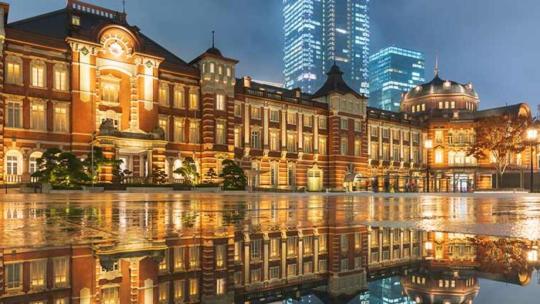
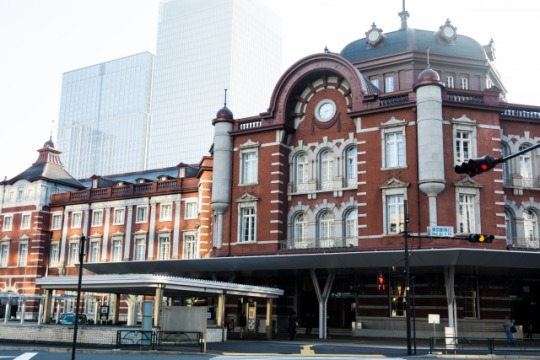

Sean bienvenidos japonistasarqueológicos, a una nueva entrega en la cual hablaremos de la famosa estación de Tokyo, uno de los pocos edificios que ha sobrevivido al paso del tiempo, ya que tras la operación doolittle y el gran terremoto de Tokio de 1923, Tokio ha sido muy remodelada, dicho esto pónganse cómodos que empezamos. - En 1908, comenzó su construcción en lo que respecta a la estación central, en 1914 empezó a funcionar, en la era Taisho 1915 Se inauguró el hotel de la estación de Tokio. En el año 1923 tiene lugar el Gran Terremoto de Kanto y el edificio de la estación no está particularmente dañado, se pudo reparar, pero la ciudad de Tokyo fue remodelada por completo y en 2007 realizaron trabajos de restauración, terminado en 2012. Hay que recordar que ha sufrido muchas restauraciones, ya que la de 1945 fue la más letal de todas. - Espero que os haya gustado y nos vemos en próximas publicaciones ¿Conocían este edificio y su historia? Que pasen una buena semana. - 今回は、有名な東京駅についてお話します。ドゥーリトル作戦や1923年の東京大震災の後、東京は大きく改造されましたが、その中でも数少ない時代の流れに耐えた建物の一つです。 - 1908年、中央駅の建設が始まり、1914年に開業、大正時代の1915年には東京ステーションホテルがオープンしました。1923年に関東大震災が起こり、駅舎は特に被害はなく、修復されましたが、東京の街は完全に改造され、2007年に修復工事が行われ、2012年に完成しました。1945年の震災が最も致命的であったため、何度も修復が行われたことを忘れてはならない。 - この建物とその歴史を知っていましたか?それでは、今週もよろしくお願いします。 - Welcome to a new installment in which we will talk about the famous Tokyo Station, one of the few buildings that has survived the passage of time, since after operation doolittle and the great Tokyo earthquake of 1923, Tokyo has been greatly remodelled, that said, make yourselves comfortable and let's get started. - In 1908, construction began on the Central Station, which became operational in 1914, and in the Taisho era 1915, the Tokyo Station Hotel was opened. In 1923 the Great Kanto Earthquake took place and the station building was not particularly damaged, it was repaired, but the city of Tokyo was completely remodelled and in 2007 restoration work was carried out, completed in 2012. It should be remembered that it has undergone many restorations, as the one in 1945 was the most lethal of them all. - I hope you liked it and see you in future posts. Did you know this building and its history? Have a nice week.
#日本#駅#東京#丸の内#銀座#歴史#建築#芸術#写真#関東地方#新宿#池袋#新橋#Japan#Station#Tokyo#Marunouchi#Ginza#History#Architecture#Art#Photography#Kanto region#Shinjuku#Ikebukuro#Shinbashi
73 notes
·
View notes
Photo
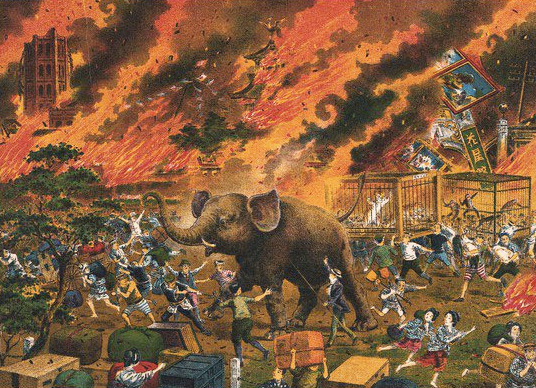
A never-before-seen print was discovered at Japan’s oldest amusement park depicting an elephant (oddly named Johnny) being led to safety during the aftermath of the 1923 Great Kanto Earthquake. Text by Spoon & Tamago
198 notes
·
View notes
Text

Ryukoku-ji: Small Buddhist Temple in Urban Jungle・台東区小さな「龍谷寺」
Ryukoku-ji, a Buddhist temple in Ueno, Taito Ward, Tokyo, Japan, features a small cemetery and a vibrant garden. Nestled amidst towering office buildings and residential apartments, it offers a serene contrast to the bustling cityscape.
Originally established in 1616, the temple was relocated to its current site in 1655. However, the original structure was severely damaged during the Great Kanto Earthquake of 1923. The temple we see today was reconstructed after the earthquake—just one of many symbols of Tokyo’s history and resilience.
Full write-up with links to sources for further reading (1-minute read): https://www.pix4japan.com/blog/20241210-tile
Timestamp: 14:08・2024/12/10 Fujifilm X100V with 5% diffusion filter ISO 1000 for 1/250 sec. at ƒ/8 Classic Chrome film simulation
#ryukokuji#buddhism#ueno#taitoward#Tokyo#japan#streetphotography#fujifilmX100V#pix4japan#龍谷寺#お寺#台東区#東京#ストリートスナップ
11 notes
·
View notes
Text
Penny Blood Inheritors Story Vol. 1 Now Available On Amazon Kindle In English

Studio Wildrose has announced that Penny Blood Inheritors Story Vol. 1 is available in English and Japanese via Amazon Kindle for $7.99.
Book Overview
Note that the following used names and terms are from translating Japanese press material: This 262-page collection of mini-narratives expands upon the dark, supernatural world of Penny Blood. Each of the three stories takes place in 1924 across different regions:
America: Penny Blood: Erebus follows investigator Alaska Packard Davidson, tackling human trafficking cases amidst the vibrant yet shadowed Roaring Twenties in New York.
Europe: Penny Blood: Hideseeker explores the partnership between Emilia Dawson (British Intelligence) and Matthew Farrell (Bureau of Investigation) as they confront a supernatural invasion threatening the continent.
Japan: Penny Blood: The Vessel of Summoners centers on twin summoners, Fusuke and Kaoruko Tsukimiya, members of the Shinteigumi Zero Squad, defending Tokyo from otherworldly creatures post-Great Kanto Earthquake.
Authors and Illustrators
Authors: Matsuzo Itchoda, Toya Katsuta, Ari Lee
Illustrators: Miyako Kato, Nobutaka Hanya
Editor: Matsuzo Machida
You can view the cover artwork for Penny Blood Inheritors Story Vol. 1 below:

About Penny Blood
Set in the 1920s, Penny Blood, the spiritual successor to the Shadow Hearts series, is a dark RPG where:
World Exploration: Players travel through regions like America, Japan, China, and Europe, encountering unique characters and odd happenings.
Psycho Sigil Battle System: Requires precise timing during attacks to maximize damage.
Fusion System: Party members transform to unleash devastating skills.
Sanity Points (SP):
Frequent interactions with demons reduce SP, driving characters to madness.
Madness grants immense strength, which can turn battles in your favor.
There is seemingly no confirmed publisher for Penny Blood at the moment.
9 notes
·
View notes
Text
在日をやってると100
最近、文章やスピーチをお願いされることがチラホラとあって、内心、「僕なんかに依頼して大丈夫なのか」と戸惑いながらもせっかくだしと引き受けては後になって後悔するというのを繰り返している。
自分で読み返すと、語彙力も無いしなんて程度の低い感想文なんだろうと思うし、後になってあれも書けなかったこれも書けなかったと気が付いて反省することが多い。
このブログでもシェアしたけれど、関東大震災の朝鮮人・中国人虐殺から99年目の2022年の9月1日にはGQ JAPANに「関東大震災朝鮮人虐殺事件から99年目──僕たちは差別を止める側、弱者を助ける側に回れるのか?(https://www.gqjapan.jp/culture/article/20220901-great-kanto-earthquake-massacre)」というコラムを書かせてもらった。2年経ったいまは在日クルド人をターゲットにしたヘイトスピーチがかなり危険ところまできていて社会はなかなか良い方向に進まないなと暗い気持ちになってしまう。 過去も現在も未来も、あの問題もこの問題も繋がっているというのがわかるようなのが書きたいなと思いながらなんとか書き上げて掲載してもらえたけれど、読み返すと、あのこともこのことも書けなかったし書くべきだったなと密かに反省していた。特に虐殺された中国人や社会主義者のこと。虐殺された社会主義者のことは僕の記事では完全に抜け落ちてしまっているし...。まとめて語られがちだけれど、数の多い朝鮮人の話がメインで語られる傾向があるけれど、そうなることでみえなくなっていることがある。虐殺された中国人ついてはぜひ @fukuyoken3daime さんのツイートの連投を読んでみてほしい。 (https://x.com/fukuyoken3daime/status/1830043385396342866)
今年はいまのところ、2つのコラムを書かせてもらっている。一つは8月6日に発売された、広島から平和を��求するマガジン「TO FUTURE ZINE 2024 -ISSUE 18-」で、2023年と2024年の入管法改悪についての文章を書かせてもらった。もう一つは、先日開催された「スナック社会科横浜映画祭#2 特集:飯山由貴」の配布資料に掲載される文章。
TO FUTURE ZINEの方はネット(https://online.recordshop-misery.com/items/88231992)で購入可能です。「スナック社会科横浜映画祭#2 特集:飯山由貴」の方ですが、公開して良いとのことなのでせっかくなので掲載しておこうと思います。作品をすでに観た人もまだ観たことない人も少しだけ違う視点をで作品を観れる文章が書けたらいいなと思いながら書いたけれど、読み返すとやっぱり上手く書けていないなと思ってしまって、あちこち手直ししたい気持ちになってしまう。でもいまそれをする時間の余裕もないのでそのままにしておきます。
無題(スナック社会科横浜映画祭#2 特集: 飯山由貴映画祭 によせて)
初めて飯山由貴さんの作品を観たのは、2022年10月15日、16日と京都の龍谷大学響都ホールでの「オールドロングステイ」の上映会に実行委員会の一人として参加させてもらった時だった。
ヘイトスピーチデモのカウンター行動で知り合った友人が、 僕が入管収容の問題に関心を持ち 大阪入管に収容されている人たちや一時的に収容から解放された仮放免の状態で生活してい る人たちの支援をしていることを知っていて映画に興味があるのではと声をかけてくれた。
入管の被収容者や仮放免者を支援するようになって、 難民、 犯罪等で在留資格を取り消され た人、 技能実習先から逃げ出すなどさまざまな理由で非正規滞在となりそれが発覚し収容され た人、ほんとうにいろいろな人と出会ってきた。 いつも支援をしながら 「特別永住」という在留 資格で生活する自分の状況と彼ら彼女らの状況を照らし合わせて考えてしまう。
支援を始めてすぐの頃、「永住者」 が犯罪で在留資格を取り消され退去を迫られている現実に 衝撃を受けた。「日本にしか生活基盤がない人に帰れってどういうこと?」 という僕の素朴な疑 問は世間一般の日本人にはなかなか理解してもらえない。
難民が入管に強制的に収容されているというのも衝撃だった。 「特別永住」の在日朝鮮人の 中には戦後、政治的な迫害(済州島四・三事件など)から逃れるために「密航」してきた人たちも いる。 元技能実習生の面会では彼らが戦前戦後の朝鮮人労���者の状況と重なった。
特別永住の資格ができる狭間で在留資格を得られなかった韓国人の老夫婦の帰国の支援を したことがある。 最初は「密航」で日本に来日し、親戚を頼って生活していたが、あるとき摘発さ れて大村収容所に収容され強制送還となってしまった。 「特別永住」の資格ができたあとに観光 で来日し、在留期限が過ぎた後もオーバーステイのまま滞在しずっと大阪でひっそりと生きてた という。 僕と出会った時の夫婦の年齢は80歳前後。 病気で倒れるまで現場作業でバリバリ働 いていたけれど、 非正規滞在のため健康保険も非加入で公的支援も何も受けられず、どうにも ならないと帰国することになってしまった。 1度目の強制送還がなければもしかしたら 「特別永 住」を取得する道もあったんじゃないだろうか。 僕よりも長く (最初の来日から数えると50年 以上)、ただ働いて生きてきただけなのになぜ医療も生活保護も受けられず日本から追い出さ れないといけないのかいまだに理解ができずにいる。
日本人と外国人の間に引かれた線、 特別永住の外国人とそれ以外の外国人の間に引かれた 線、 永住の外国人とそれ以外の外国人の間に引かれた線、 あちこちに引かれた見えない線がほ んとうに正しいのか社会に問いかけるにはどうしたらいいのか。 そういうことを日々考えてい たときにたまたま観ることになった「オールドロングステイ」は大きなヒントをくれたように感じている。 外国人登録令による日本国籍喪失とその後の参政権や社会保障からの排除、 民族教育を否定 する通達、日本国憲法の制定過程など植民地主義を根にするさまざまな問題、ハンセン病療養 施設における朝鮮人差別と格差是正運動、 帰化制度における差別、 在日朝鮮人の中の障害者差別など、 在日であり障害者であることで受ける差別の背景に広く深く迫ることで引かれた線を次々に可視化しているのが良かったし、普段はなかなか可視化されない声なき声を描くのに、安易にわかりやすくして伝えない、受け手の本気度が試されるような表現の仕方もおもしろいと思った。 その後に観たのは、戦前に都内の私立精神病院に入院していた2人の朝鮮人患者の診療日 誌のことばをモチーフに、ラッパー・詩人の FUNI の声と身体で映像化した作品「In-Mates」。 この作品は東京都の指定管理施設「東京都人権プラザ」で開催された企画展「飯山由貴 あな たの本当の家を探しにいく」 (2022年8月30日~11月30日) において上映が禁止とさ れて大きな���題となった。 (詳細は記事を参照→東京都人権部による飯山由貴 《In-Mates》上 映不許可事件は、何を問うのか https://t.co/7fk561FzCn )
上映禁止について語られることが多いこの作品。 自分自身が在日朝鮮人であり、さらには父 親がアルコール依存症で精神科病棟に強制入院となってその中で死亡していること、そして、今 現在、入管の収容施設に強制収容されている人たちや、仮放免という身分で一時的には外に出 られたものの、 就労も、 健康保険加入も、移動の自由も制限され、ほとんど何もできない生活を 強いられている人たちの支援をしていることもあって、 強く心を打つ作品となった。 患者 A、患 者Bの生きてきた環境やそれによって形成されたアイデンティティを想像すると言葉にならな い感情が湧いてきた。
入管の被収容者や仮放免者の支援をするようになって”自由”に対する感覚が随分とかわっ た。 アクリル板の向こう側、 握手すらできないところで何ヶ月も何年も小さな部屋に閉じ込めら れている人との会話。 仮放免された瞬間の表情としばらくして就労もできず結局は自由がない 生活に苦しんでいる表情。
「In-Mates」のエンディング、ニーナ・シモンの「I Wish I Knew How It Would Feel To Be Free」は支援で出会った人たちの表情を思い出してしまいとても重かった。
無いことにされてしまっている声、 叫びに気付き可視化していく飯山由貴さんの作品。 この先も追いかけたい。
8 notes
·
View notes
Text
The synopsis of Bubblegum Crisis is so unintentionally funny.
The year is 2032, seven years after the Second Great Kanto Earthquake decimated Tokyo. Now, the city is reborn as MegaTokyo, built from the labors of mechanical beasts known as "Boomers."
Under the ever looming Boomer threat, a group of four girls from varying degrees of society banded together
While spending a night out, Linna Yamazaki, a new employee at the Hugh-Geit Corporation (a Genom subsidiary), observes a Boomer that has “gone rogue”, causing destruction and attacking people.
Over the course of the series, the Knight Sabers go after rogue boomers
38 notes
·
View notes
Text
An attempt of a timeline for Demon Slayer
Hi, hello, I am on a brainrot and for the sake of OC creation I decided to put a year and age to as much as I can in Demon Slayer.
What we know?
Demon Slayer takes place in the Taishō Era which goes from 1912 to 1926
But there are two things in the world building that can allow us to determine when the anime takes place in and from there develop a timeline of what happens when.
Beware, this will have spoilers for the late part of the timeline!
The presence of Moga
What are Moga? "The Modern girl" was a movement that occured in Japan during the Taisho Era where young women embraced the western style as a form of liberation from the traditional, men driven ideologies in Japan in search for financial and emotional independence.

We can see a couple examples of what might be Moga when Tanjiro arrives to Tokyo!


Muzan's own wife seems to follow Moga fashion even!

But we can't be sure if that's due to her own choice or Muzan trying to push his wish for Modernity on her, you know that demon denies staying in the past so probably would ask his wife to Mordernize herself as well -Even though between women her age and social status back then, wearing traditional japanese kimonos was the "Normal". Men were the ones who normally to show wealth wore western fashion-
The term of "Moga" was actually not adopted until 1923, but the movement could be tracked to the publishing of magazines as The Housewife's Friend, which was founded in 1917.
So if we follow these mere hints, we could say that Demon Slayer takes place between 1917 - 1923.
But there is something else that could give us THE EXACT YEAR of when the story takes place!
The Yoshiwara District and its destruction

The flashiest arc of the story takes places in The Enterteinment District of Yoshiwara, one of the 3 three licensed and well-known red-light districts in Japan alongside Shimabara and Shinmachi.

Knowing that this is Yoshiwara gives us an excellent reference of what year the story could take place in, and while personally I am not sure if Gotōge did it intentionally or not -Probably it was- The destruction of Yoshiwara in the battle against Gyutaro and Daki could have been easily been hidden by the Demon Slayer Corps by one catastrophe that happened in Japan during that time: The 1923 Great Kanto earthquake

The district of Yoshiwara was destroyed to point of near-obliteration after this catastrophe in Japan. And while a great tragedy, it could give the best smoke curtain to such big battle as the one against the Sixth Upper Moon was, as we know- The Enterteinment District got pretty roughed up during that battle, thanks Gyutaro.
SO! With this, I can say that the year in which the main story of Demon Slayer might take place in is 1923!
So with that settled! We can go into the timeline!

Meiji Era (1896 - 1912)
1898: Jigoro Kuwajima (35) retires from being the Rumble Hashira due to an injury
1904: Suicide of Kagaya Ubuyashiki's father, Kagaya (4) raises as the new Oyakata-Sama
1909: Death of Kagaya (9) 's younger brothers: Senri (8) and Akito (6), and of their mother, by a house fire provoked by Senri.
1911: Ruka Rengoku dies. Leaving Kyojuro (8) and Senjuro (2) without their mother, Shinjuro Rengoku, the current Flame Hashira, starts spiralling into a heavy depression.

Taishō Era (1912-1926)
1914: Kaigaku (11-12) lets a demon into the orphanage run by Gyomei Himejima (18), all the orphans die with the exception of one who frames Gyomei as the killer. Kagaya (14) saves Himejima from execution.
1915: Giyu Tomioka (13) succeeds in his Final Selection.
1916: Gyomei Himejima (20) becomes the Stone Hashira.
Tengen Uzui (16) joins the Demon Slayer Corps.
1918: Giyu Tomioka (16) becomes the Water Hashira. Tengen Uzui is already the Sound Hashira and Kanae Kocho is already the Flower Hashira.
Sanemi Shinazugawa (16) becomes the Wind Hashira
1919: Kanae Kocho (17), dies fighting the Upper Moon 2: Douma.
1921: Shinobu Kocho (16) becomes the Insect Hashira.
The Kamado family is slaughtered by Muzan, Nezuko (12) is the only survivor and turned into a demon. Tanjiro (13) tries to get his sister to a doctor, and on the way are attacked, and spared, by the Water Hashira, Giyu Tomioka (19)
Kyōjurō Rengoku (18) becomes the Flame Hashira.
1922: Obanai Iguro (20) becomes the Serpent Hashira
Muichirō Tokito (13) becomes the Mist Hashira.
Mitsuri Kanrōji (18) becomes the Love Hashira
1923: Giyū Tomioka (21), Shinobu Kōchō (18), Kyōjurō Rengoku (20), Mitsuri Kanrōji (19), Obanai Iguro (21), Sanemi Shinazugawa (21), Gyōmei Himejima (27), Tengen Uzui (23) and Muichirō Tokito (14) are the current generation of Hashiras under the leadership of Kagaya Ubuyashiki (23)
Tanjiro Kamado (15), Inosuke Hashibira (15), Kanao Tsuyuri (16), Genya Shinazugawa (16) and Zenitsu Agatsuma (16) succeed on their Final Selection. The main story of Demon Slayer starts.
1924: Muzan Kibutsuji is defeated and the demons are destroyed once and for all.

And I might have skipped some stuff, or I might even have some stuff wrong but I think this is rather solid? Anyway, you are welcome to take this as guide or just think I'm delulu! After all I'm just a fan with brainrot doing this for the sake of roleplay and OC making lmao
#kimetsu no yaiba#demon slayer#kny timeline#kny theory#demon slayer timeline#demon slayer theory#drax talks
10 notes
·
View notes
Text

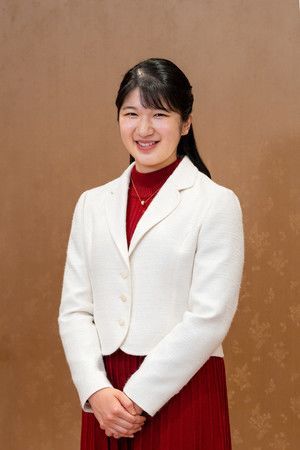
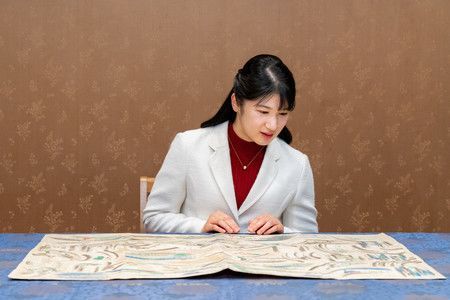
Japanese Princess Aiko, the only child of Emperor Naruhito and Empress Masako, turned 22 on Friday, as she is leading a busy and fulfilling university life.
The princess is currently in her final year at the Faculty of Letters at Gakushuin University in Tokyo. After pandemic-related restrictions were lifted in the country, in-person classes resumed for many courses at her university.
She started to attend classes on campus this spring. Based on literature from Japan's Heian, Kamakura, Edo and Meiji periods, she is working on her graduation thesis. Meanwhile, the princess enjoyed the university's school festival in November, according to the Imperial Household Agency.
In addition to Japan's traditional culture, the princess is interested in welfare activities. In October, she and her parents visited the headquarters of the Japanese Red Cross Society to see a special exhibition on relief activities following the 1923 Great Kanto Earthquake.
She also looked around the permanent exhibition there and seemed to be impressed by the involvement of Empress Dowager Shoken, the wife of Emperor Meiji, in the early years of the organization's activities.
Source
#princess aiko#emperor naruhito#empress masako#japanese imperial family#imperial family of japan#japan#japanese monarchy
21 notes
·
View notes
Text
Polished Crystal Review and First Playthrough


I did a catch'em all first playthrought. It was great!
Despite being still in development, this Romhack is great. Is Pokemon Crystal with so many quality of life enhancements it's not funny. There is tons of bonus content, later series game mechanics, anime cameos and enhanced difficulty boss battles.
There loads of bonus areas and extra trainers, largely solving the level curve problems of crystal at the expense of making the game slightly more linear. The spritework is incredible, with the new areas looking great and the in-team sprites and future generation move animations looking both great and like they belong. There are even custom shinies.
This is HGSS+ using the Crystal game engine, and it's great. I have unlocked the new game plus, and I intend to use it sometime.



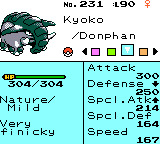
Kyoko, my trust Sturdy Donphan who I meet as a level 2 Phanphy on Route 46. Sturdy works as a focus band, and with rollout and defense curl she was great early on and several early gyms need her help as my Chikorita starter was still even with the changes. Sturdy was great, as being able to ensure a knock off or earthquake was the key to several battles. She enabled me to beat the surprise level 80 Giovanni Mewtwo by heal spamming until it ran out of PP. I always wanted to use a Donphan in a playthrough of gen 2, and now I have.
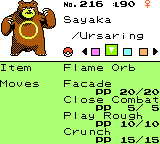

Meet Sayaka, a Guts Ursaring and Sayakas partner, caught in dark cave as a level 2 Tediursa. She too was great early game, hitting hard with strong physical type moves and doing great damage. After falling behind she evolved and spent the entire game hitting hard for massive damage. While sadly a bit slow and rarely getting in multiple attacks, when she hit she hit hard. Flame Orb is an item you get prior to E4 in game, and while she only got Facade in Kanto her friendship powered return hit hard. Ursaring was another Gen 2 pokemon I wanted to use in a playthrough, and she did fine.
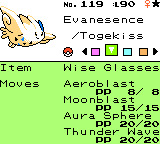

Originally Pearlshine, the egg Togepi with Serene Grace whose sing proved invaluable in catching mons and stunning bosses. After becoming the Johto Champion, I battled Cynthia and got a Shiny Togepi egg with Superluck, Aeroblast and Moonblast. Since regular Togekiss can't get Moonblast in this game, I swapped them and trained up Evanescence with an exp share. Both of them were great team mates, with Pearlshine being very bulky early on while Evanescence was far more offensive.

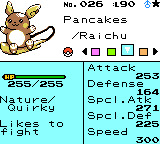
Hatched from daycare couple egg, was Pikablue the shiny blue Pichu who soon evolved into a blue Pikachu. Equipped with a Light Ball, I decided to evolve Pikablue into an Alolan Riachu as beating gen two with an Alolan Riachu seemed sweet. This took till after beating the elite four to find the item, but it was worth it. Rename Pancake, now with Motor Drive as the hidden ability and holding a focus sash, Pancakes was my fastest team member and could on rare occasion gets off a nasty plot to do massive damage.
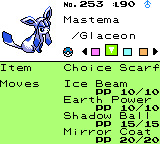

Mastema, the Snow Cloak Glaceon was the Eevee I got from Bill. Needing to level up in Ice Path he spent a long time unevolved and doing poorly in my team. Upon evolving though he crushed Team Rocket and became a strong special attacker who spammed high power special moves. Using a Glaceon in Johto was fun, and with a choice band to actually outspeed late game opponents he was great.
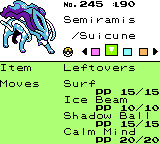

Last, but certainly not least is Suicune, a pokemon I always wanted to use in a playthrought and my originally planned team member. She originally held an assault vest which worked well with Pressure, and was an extremely specially bulky team member whose final move was mirror coat. And then I beat Sabrina, got Calm Mind and she became my Ace Mon whose ability to set calm minds sweep is the only reason I was able to beat Red and Green, and was a key part of my rematch with Lance.
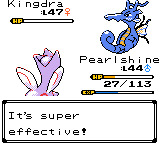
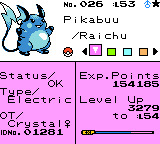
#pokemon#pokemon used#pokemon archive#pokemon review#pokemon polished crystal#polished crystal#pokemon romhack#Alolan Riachu#Togekiss#Ursaring#Donphan#Glaceon#Suicune
11 notes
·
View notes